Powering up
02 August 2017
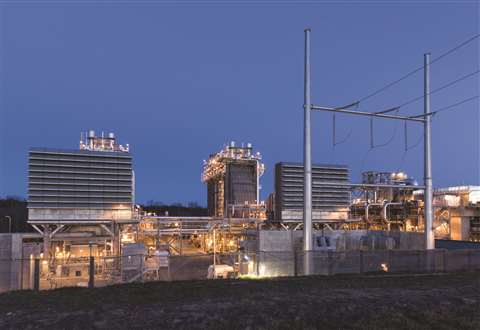
Bechtel helped to build the Stonewall Energy Facility in Virginia, USA – a 778-megawatt combined-cycle generating station
The world is moving towards a sustainable future and the huge number of renewable energy projects that are sprouting up each year are proof of this. Wind, hydroelectricity, liquified natural gas (LNG), solar and energy from waste (EfW) are all big players across the world, giving the construction industry a steady stream of work and moving forward hand-in-hand with more traditional power projects.
The construction of a combined-cycle generating station – using both a gas and a steam turbine to produce electricity – was recently completed by USA-based construction giant Bechtel with the Stonewall Energy Facility in Loudoun County, Virginia for private equity energy funds company Panda Power Funds. In May 2017, the company took over commercial operation of the 778-megawatt combined-cycle generating station; a cleaner, gas-fired power plant that can supply electricity to up to 778,000 homes.
Stonewall uses ‘advanced’ emissions-control technology and is cooled with treated wastewater, which helps to conserve the natural supply of drinking water in Virginia, and prevents the discharge of nutrients into the Potomac River and Chesapeake Bay watershed.
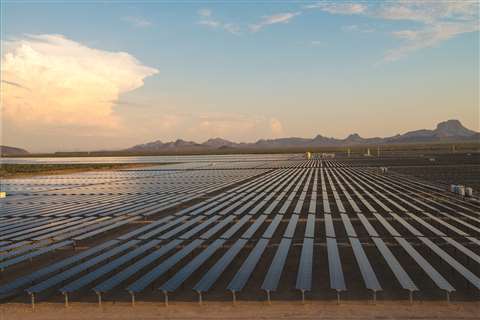
Fluor took on an EPC contract to design and build a 125-megawatt solar photovoltaic (PV) facility in Arlington, Arizona, USA
Bechtel created the facility alongside Siemens, who was responsible for the core power elements including natural gas and steam turbines, generators and waste-heat-recovery boilers. It is expected to generate $20 million USD a year in ‘direct and indirect spending’ in Loudoun County.
Combined-cycle projects have been completed in the United Kingdom, Netherlands, Taiwan, Egypt, Mexico, Turkey, Brazil and, of course, the USA.
A company that is helping to make sustainable energy available to rural and remote areas is Caterpillar Ventures (the investment arm of Caterpillar), who, last year, invested in Powerhive – a tech venture that partners with utilities and independent power producers to provide access to ‘productive, affordable and reliable’ microgrid electricity for millions of rural homes and businesses.
Microgrid power brings clean energy to rural areas without access to typical power providers. Caterpillar Ventures also has generator sets, energy storage and photovoltaic (PV) panels as part of its microgrid services.
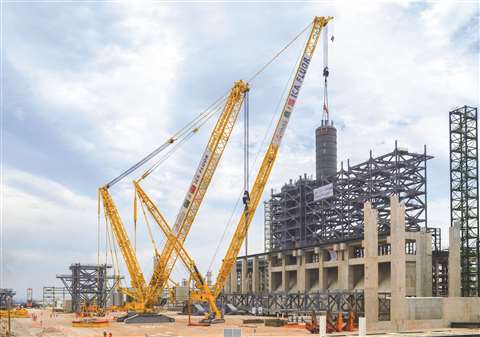
Liebherr’s LR 13000 crawler crane in action on the modernisation of the Miguel Hidalgo oil refinery in Tula, Mexico
George Taylor, VP and chief marketing officer at Caterpillar Ventures, says, “We know leveraging external know-how and resources by collaborating with a variety of external companies is key to driving innovation and improving our overall customer experience.”
Sustainable future
Volvo’s construction division, Volvo CE, launched a brand campaign last year to promote the ways in which it is helping to drive a more sustainable future. ‘Building Tomorrow’ episode one showed how Volvo CE helped to build an ice hotel in Northern Sweden using ice harvested from the nearby Torne River. The second episode followed the building of the sustainable Lusail City, which will support 250,000 residents.
The third episode, released in June, has a renewable energy focus as it follows a wind farm project in South Africa. Kouga Wind Farm, on the Eastern Cape coastline, is part of a governmental program to harness the country’s ideal weather conditions while ‘integrating socio-economic development’.
Volvo says that in 2016, for the first time ever, renewables became the largest power source in the world. The wind power market has seen incredible growth due advancements in technology and international government support.
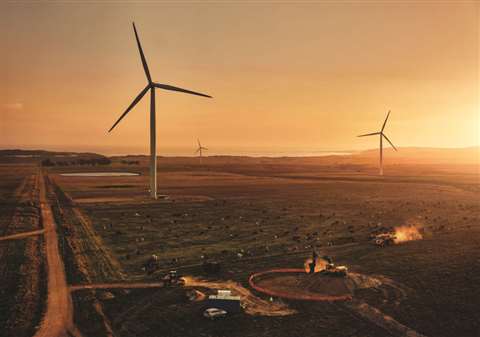
Kouga was set up as part of the Renewable Energy Independent Power Producer Procurement Programme (REIPPPP) in response to South Africa’s long-term need for energy. The wind farm is located about 70 kilometres southwest of Port Elizabeth, also known as the ‘windy city’. It has an ambitious target of producing 18,800 megawatts from renewable resources by 2030.
Construction began in 2013 with the first of the giant turbines coming online in March 2015. The community surrounding the wind farm also own 26 percent of the wind farm, thanks to guidelines set by the REIPPPP.
Speaking about the Kouga Wind Farm, Mats Bredborg, global director of brand management at Volvo CE, says, “It really shows how the transition to renewable energy can boost business and at the same time empower the local community to a greener, brighter and more sustainable tomorrow.”
Currently home to 32 turbines, the wind farm generates approximately 300 million kilowatt-hours of clean electrical energy per year, which reduces greenhouse gases by up to 270,000 tonnes, says Volvo CE.
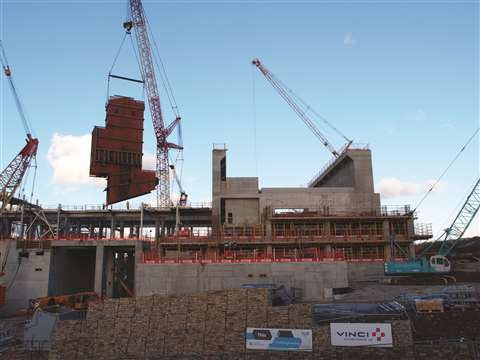
The UK’s Cornwall Energy Recovery Centre was completed by Vinci Environment in partnership with Taylor Woodrow
Another manufacturer who has a steady flow of jobs in the energy sector is Liebherr. The manufacturer’s LR 13000 crawler crane – said by the company to be the largest in the world – has recently been used in the modernisation of the Miguel Hidalgo oil refinery in Tula, Mexico. Mexico-based crane contractor ESEASA carried out the hoisting work on behalf of construction contractor ICA Fluor.
When the work is concluded, by the end of 2018, the refinery will be able to produce up to 10,000 more barrels of pure petrol and diesel, says Liebherr. The job involved hoisting six tanks, each weighing 620 tonnes, in to position to a hook height of 124 m with a radius of 54 m.
The LR 13000 had a 132-metre main boom, including PowerBoom and the derrick boom with 1,725 tonnes of ballast. The job also required the use of a LR 11350 crawler to help to tandem hoist the tanks in an upright position, and a LRT 1100 telescopic crawler that removed the transport device from the tanks after they had been placed upright.
The tanks will be used to store the carbon produced during the production process at the refinery.
Waste not
In the United Kingdom, a joint venture between housebuilding and construction company Taylor Woodrow and Vinci Environment – the special subsidiary of Vinci Construction – has recently completed the Cornwall Energy Recovery Centre (CERC). The contract, worth approximately £145m, saw the partnership deliver a ‘key facility’ in the county’s integrated approach to waste management.
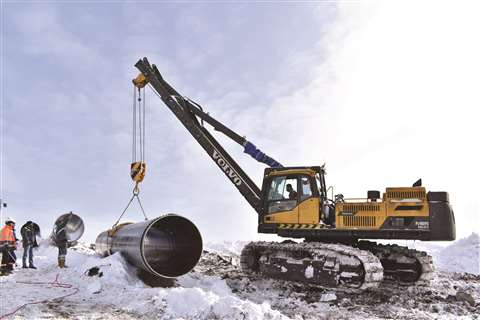
The CERC will be able to treat up to 240,000 tonnes of residual waste each year, as well as exporting electricity to the grid equivalent to the annual average consumption of more than 21.000 households. The centre will be operated by SUEZ Recycling and Recovery UK.
As an energy from waste (EfW) plant, the CERC processes residual waste under controlled conditions to generate steam, driving a turbine and generating power. It also has a bottom ash recycling plant, treating the residue from the combustion process, separating out metals and creating various grades of secondary aggregate.
Vinci Environment designed and delivered all works on site from its start in 2013 – minus the high voltage grid connection and the sorting equipment of the bottom as recycling plant – and at the most concentrated period of construction, the workforce was over 400 people.
To minimise the environmental impact of the project, the team used locally sourced products such as Cornish granite, rainwater harvesting for the centre’s water consumption as well as sedum roof.
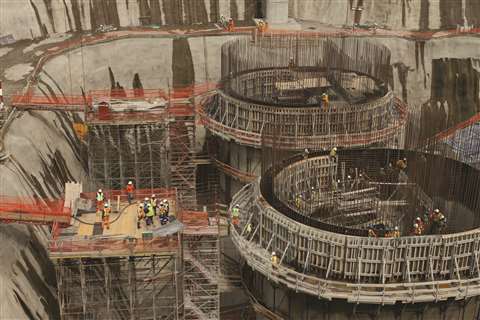
Salini Impregilo helped to build the Ingula Pumped Storage Scheme (IPSS) near Johannesberg, South Africa
Julian Gatward, Taylor Woodrow managing director, says, “Sustainable construction has been at the heart of the project ethos, which has generated fantastic achievements during the construction phase such as working a million hours accident free, alongside benefits that will last for years to come.”
In terms of technical and construction challenges, the partnership had to construct special foundations for the stacks and steam turbine, complex architectural features and lifting equipment weighing up to 160 tonnes into a tight structure. They also had to program a ‘complex’ centralised control system to allow the automated operation of the CERC.
USA-based construction giant Fluor announced in June that the US Department of Energy (DOE) has selected the Four Rivers Nuclear Partnership (FRNP) – a joint venture of CH2M, Fluor and BWX Technologies to lead the Paducah Deactivation and Remediation (D&R) contract at the Paducah Gaseous Diffusion Plant in Kentucky.
The performance-based contract is valued at $1.5 billion (approximately) over 10 years.
The 3,500-acre site, 3.5 miles south of the Ohio River, was built in the 1950s as part of the nation’s nuclear weapons complex, it processed uranium from 1952 to 2013 for military reactors, nuclear weapons and nuclear power plant fuels.
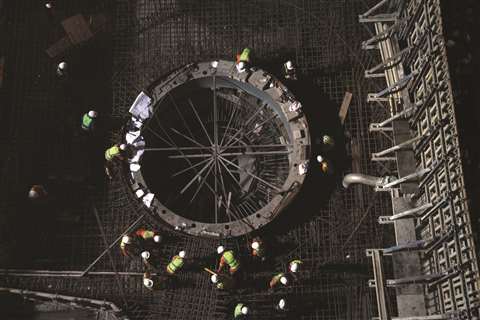
Called a virtual green giant, the Ingula project was completed with the help of Salini Impregilo and this image was the July/August 2016 IC cover
Brice Stanski, president of Fluor’s government group, says, “We’ve made facilities safer by removing hazardous and radioactive materials while improving the site’s infrastructure. These efforts will save taxpayers millions of dollars over the next several years while improving safety for the workers, the public and the environment.”
Throughout the contract duration, which includes the management of more than 650 structures, buildings and properties, the team will reduce risks and future demolition costs by enhancing surveillance and maintenance costs.
The company also recently signed an agreement with JGC America to provide construction-related support to the front-end engineering and design (FEED) services for an liquified natural gas (LNG) project in the District of Squamish near Vancouver, Canada.
As a subcontractor, Fluor will provide construction planning and design services for the Woodfibre LNG project. The facility will be powered by BC Hydro, which is said to generate 90 percent more than 90 percent clean renewable energy and will help to create one of the ‘cleanest LNG facilities in the world’.
Pierre Bechelany, senior vice president of pipelines and LNG for Fluor, says, “Leveraging JGC’s extensive LNG experience and Fluor’s project execution and construction expertise, we look forward to helping Woodfibre LNG advance this project for the community and British Columbia.”
Underground giant
Italy-based construction and civil engineering company Salini Impregilo helped to build the Ingula Pumped Storage Scheme (IPSS) – a power plant and a pumping station with a dam and accompanying reservoir on either side of it – along with the CMI Joint-Venture and other partners.
The project was completed in January, helping the country’s biggest utility (Eskom) to meet the growing demand for power in South Africa. It was also International Construction’s cover star in the July/August 2016 issue.
Located 350 km south-east of Johannesburg, South Africa, at the border between Kwa Zulu Natal and Free State, the project was to allow the production of electricity at peak times and re-utilisation of the water in times of lower demand.
The works involved underground civil works including:
- Installation of four pumps/turbines
- Pumping and return tunnels
- Balancing shafts
- Underground excavations for the plant and transformers
- Access tunnels to the various structures
- Upstream and downstream intake works
It is described by Salini Impregilo as a virtual green giant, and is also one of the few power stations in Africa that recycles the water it uses – up to 80 percent.
IPSS uses a system known as pumped hydroelectric storage (PHS) but, unlike a normal hydroelectric plant, it only produces electricity when the need arises. The hydroelectric energy stored in the form of water behind the dam’s reservoir can be put into action in less than three minutes, says Salini Impregilo.
Ingula’s design and construction follows the principles of sustainability and is ‘especially attentive’ to the surrounding environment. It is 116 storeys underground, leaving a ‘virtually undisturbed’ surrounding area. The only sections left visible are the dams and their reservoirs, the inlet and outlet structures and the capping structures of the surge shafts.
With hydroelectric energy stored in the form of water behind the upper dam’s reservoir, it can be put into action in less than three minutes. The reservoir’s storage capacity is 21,000 MW hours once it is filled with water.
Ingula is the fourth of its kind to be built in South Africa but it is the largest in terms of generating capacity at 1,332 MW.






